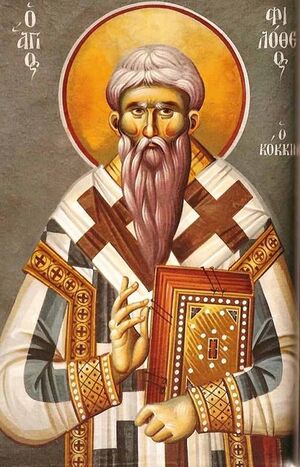Filotei I (Kokkinos) al Constantinopolului
Cuviosul Părintele nostru Filotei I (Kokkinos) a fost Patriarh al Constantinopolului în secolul al XIV-lea în două rânduri: între 1354 și 1355, iar apoi între 1364 și 1376. A fost anti-unionist (împotriva unirii cu Roma), împotrivindu-se împăratului Ioan al V-lea în dorința acestuia de la negocia o reuniune bisericească - între Biserica Răsăritului (ortodoxă) și Biserica Romei (catolică) - cu papii Urban al V-lea și Grigorie al XI-lea. Prăznuirea lui în Biserica Ortodoxă se face la 8 octombrie.
Viața
Filotei (sau Filoteu) era de loc din Tesalonic și se crede că s-a născut în jurul anului 1300. His mother was a Jewish convert. He entered a monastic life early, becoming a monk at Muntele Sinai and later he became the abbot of the Great Lavra on Muntele Athos. At Mount Athos he was a close friend of St. Grigorie Palama and became a follower and advocate of the form of contemplative prayer, Isihasm.
In 1347, Philotheus was consecrated Metropolitan of Heraclea, in Thrace. Becoming a protege of co-Emperor John VI Cantacuzenus, Bp. Philotheus spent most of his time in Constantinople. In 1354, he was appointed Patriarch of Constantinople by John VI. In 1355, after John V Palaiologus obtained the abdication of John VI and forced him into a monastery under the name Joseph Christodoulus, he then forced the deposition of Patr. Philotheus.
In 1364, Patr. Callistus stepped aside and helped restore Philotheus to the patriarchal throne. In 1376, Patr. Philotheus was deposed by Emperor Andronicus IV, when he ascended to the imperial throne. Philotheus reposed in exile in 1379.
Administration
In 1354. the Ottoman Turks gained a foothold in Europe, at Gallopoli, threatening Constantinople from a new side. Threatened anew, John V appealed to the West for help in defending Constantinople against the Turks, proposing, in return, to end the schism between Constantinople and Rome. Opposed to re-union on political terms, Patr. Philotheus was against the efforts by John V to negotiate with Popes Urban V and Gregory XI.
Patr. Philotheus pursued an ecclesiastical policy to consolidate under the jurisdiction of the Constantinople patriarchate the Orthodox churches of the Serbians, Russians, and Bulgarians and to assert a primacy over the entire Eastern Church. He actively intervened in the affairs of Russia such that all the ecclesiastical administrative functions were consolidated under the Metropolitan of Kiev, Cyprian, who resided in Moscow.
Patr. Philotheus was an advocate of Hesychasm, and aided the cause of the Hesychasts in 1368 by supporting the canonization of Gregory Palamas at a local synod.
Patr. Philotheus was a writer of note, writing works on the theology of the Uncreated Energies of God and attacking the scholastic philosophy that was then current in the Western church. His most famous work is the Hagiorite Tome, the manifesto of the Mount Athos monks on how the Saints partake of the Divine and uncreated Light that the Apostles beheld at the Transfiguration of Christ.
| Filotei I (Kokkinos) al Constantinopolului | ||
|---|---|---|
| Precedat de: ? |
Metropolit de Heraclea 1347-1354 |
Urmat de: ? |
| Precedat de: Calist I |
Patriarh al Constantinopolului 1354-1355 |
Urmat de: Calist I |
| Precedat de: Calist I |
Patriarh al Constantinopolului 1364-1376 |
Urmat de: Macarie |
Surse
Categorii > Istoria Bisericii
Categorii > Istoria Bisericii
Categorii > Liturgică > Sărbători > Sfinți
Categorii > Liturgică > Sărbători > Sfinți > Sfinți bizantini
Categorii > Liturgică > Sărbători > Sfinți > Sfinți greci
Categorii > Locuri > Ortodoxia pe țări > Ortodoxia în Grecia
Categorii > Oameni
Categorii > Oameni
Categorii > Oameni
Categorii > Oameni > Cler
Categorii > Oameni > Cler
Categorii > Oameni > Cler
Categorii > Oameni > Episcopi
Categorii > Oameni > Episcopi
Categorii > Oameni > Episcopi > Episcopi după localitate > Patriarhi ai Constantinopolului
Categorii > Spiritualitate
Categorii > Spiritualitate > Ascetism
Categorii > Teologie > Isihasm
Categorii > Viața Bisericii > Monahism
